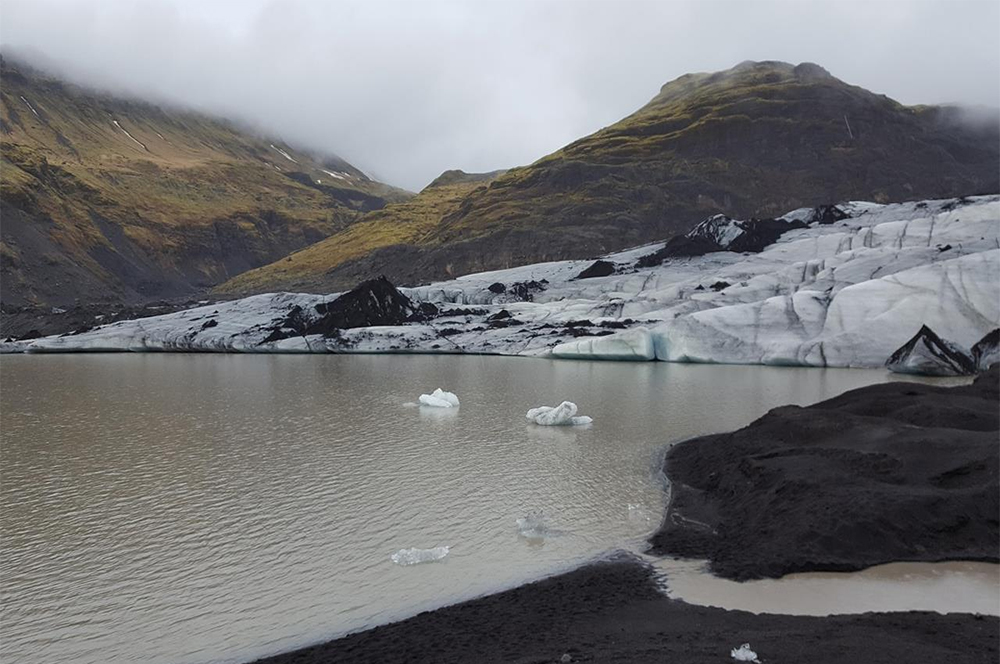Even if you can’t pronounce it, you’ve probably heard of Eyjafjallajökull — the Icelandic volcano that erupted beneath a glacier in 2010, spitting up a massive ash cloud that grounded millions of air travelers around the world. Nearby sits an even bigger, much more powerful volcano named Katla. I want to get close, though given recent warnings about increased seismic activity and that it’s decades overdue for a throat clearing, not too close.
Which means hiking Sólheimajökull instead. This 200-meter-thick glacial tongue extends from a major ice cap that sits atop the testy Katla, which, if it were to blow, could trigger an outburst flood in my direction. Sure, government authorities are reportedly aware of the spotty cell phone reception in this area and are working on a text message warning system in the event of an eruption. But who’s really going to whip out a phone to check texts on a chilly trek?
I feel more reassurance from my guide, Ármann Ragnar Ægisson of Extreme Iceland, who checks my climbing harness before we begin walking on a black sand trail to the glacier’s edge. The 26-year-old Nordic adventurer is a soft-spoken pragmatist: My ice ax, he notes, is mostly just for looks but could come in handy during steeper steps. And when it comes to a flood escape plan? “It’s basically just getting off the glacier as soon as possible,” since floods come down on the sides, Ægisson explains. “The glacier doesn’t break up.”
Good to know. Also good to know: The glacier can break up you. I start my ascent by digging my spiky crampons into ice-carved steps and soon spot some of Sólheimajökull’s seductively dangerous cracks, sink holes and ice ridges. Crevasses stretch up to 30 meters here, and the deepest moulin (a shaft shaped by meltwater) that Ægisson knows of measures 70 meters. In 2011, Daniel Markus Hoij explored this same aqua-colored terrain with its hypnotizing swirls of volcanic ash and dirt and ended up in a narrow crevasse and died from exposure. So I welcome Ægisson’s steady hand and grip on my harness so I can lean over and peek down nature’s drainpipes, watching as ice melt and rainwater cuts through Sólheimajökull’s frozen surface and, at one point, gets U-turned by defiant ice that seems to push a stream backward.
Up here it’s ice against climate change, and resistance seems futile. There’s one ice cave I’m only partially allowed to enter because warm weather and rain are softening it into nothingness. Sólheimajökull is shrinking. It, along with “most Icelandic glaciers, will retreat and eventually disappear over the next 100 to 200 years,” warns the Icelandic Meteorological Office, a public institution. On our descent, Ægisson pauses above a growing lake at Sólheimajökull’s base; the sandy walk to the actual glacier has been taking longer and longer to complete since he first trekked here in 2008. “We’re now waiting under the mountainside under steep hills with potential for rock slides during the melt cycle in the spring and heavy days of rain,” Ægisson says.
Today is one of those wet, warming days. Some volcanic rocks slip and slide at our side, though they’re at a safe distance and not as treacherous as the slow-falling landslide that forced tour companies to cancel tours here one day. Just weeks after my trek, Ægisson tells me this entire area ended up closed for a few days due to seismic tremors beneath Katla’s ice cap. “Some volcanoes give a month’s warning,” he says. “Sometimes it’s just 30 minutes before. It might erupt before warning.”
GO THERE: EYJAFJALLAJÖKULL
There are various ways to hike Sólheimajökull, including pricey private tours. Visitors to the glacier are warned they’ll need proper equipment plus a guide.
Extreme Iceland
You get: three hours with a guide, including 1.5 hours on the ice, plus safety equipment, such as a helmet, crampons and ice ax.
You need: warm and waterproof clothes, sturdy hiking shoes and around $100.
Arctic Adventures
You get: 3.5 hours with a guide, including 1 to 1.5 hours on the ice, plus safety equipment, such as crampons.
You need: warm and waterproof clothes, sturdy hiking shoes and around $120.
Arcanum
You get: three hours with a guide plus safety equipment, such as a helmet, crampons and ice ax.
You need: warm and waterproof clothes, sturdy hiking shoes and around $150.

